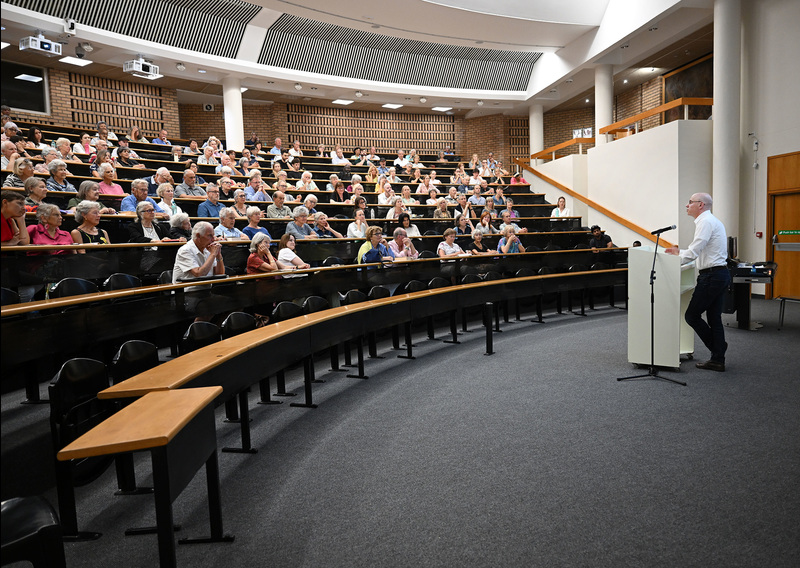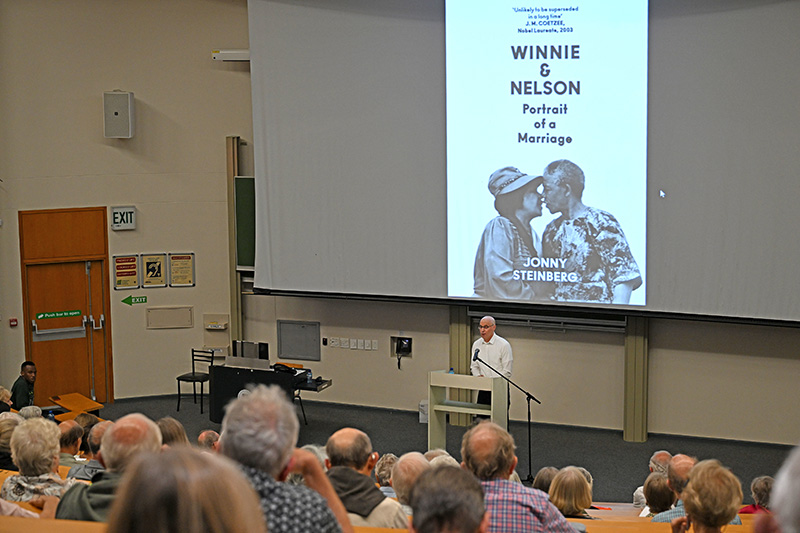Snippets from the story of Winnie and Nelson Mandela
27 January 2025 | Story Niémah Davids. Photos Lerato Maduna. Read time 9 min.
The story of South Africa’s political power couple Winnie and Nelson Mandela, as told by award-winning writer and scholar Professor Jonny Steinberg, captivated a Summer School lecture audience. They were offered a glimpse into “the fractures and stubborn bonds at the heart of a volatile and groundbreaking union”.
Professor Steinberg’s talk was based on his book, Winnie and Nelson: Portrait of a Marriage, and was held in the Kramer Law Building on lower campus on Thursday, 23 January. The lecture formed part of the University of Cape Town’s (UCT) 2025 flagship Summer School series – the largest public learning showcase on the continent.
How it all began
Winnie and Nelson’s story began in January 1957 in Johannesburg. As a 38-year-old lawyer (Madiba) drove his car from Soweto to central Johannesburg, it was hard not to notice the “absolutely gorgeous” woman (Winnie) at a bus stop who was about half his age (19 or 20 years old). Steinberg said Madiba contemplated stopping his car for a moment. But he decided against it. Instead, he found out who she was and got her telephone number; and a little over a year later he was divorced from his wife at the time, and he married Winnie.
“That is what happened between them. But there’s something about the two of them which twists the story into something else, something much grander; and that is that both of these people are from the very elite of their worlds and are born to lead,” said Steinberg.
He told the audience that Madiba was born and raised in the royal house of abaThembu, attended the most elite, prestigious schools, and later went on to become a lawyer. He was one of only 65 black attorneys in Johannesburg. Similarly, Steinberg said, Winnie too was born into a Xhosa royal family. She attended the finest missionary schools for young black women, and later qualified as a social worker.
“So, intuitively maybe even subconsciously, from the very beginning, they understood that their marriage was not [just a union] between two people. It was a political asset.”
“When these two people came together, they were very flashy, they were very modern. And they both understood something: they understood that what they looked like was powerful, but not just in a superficial celebrity way, in a political way,” he said. “So intuitively, maybe even subconsciously, from the very beginning, they understood that their marriage was not [just a union] between two people. It was a political asset.”
The winds of change
Madiba and Winnie were married for just two years when the Sharpeville Massacre took place and led to the banning of the African National Congress (ANC) and the Pan African Congress (PAC). It was around this time, Steinberg said, that Madiba went underground, and together with other comrades made the “controversial decision” to establish uMkhonto weSizwe – the armed, military wing of the ANC. While underground, he became the most famous black man in the country. And as much as South Africa was focused on him, Steinberg said, they were also focused on his wife and two young daughters at home.
He reminded the audience that when Madiba was caught, his arrest led to the highly publicised Rivonia Trial, and he was subsequently sentenced to life in prison.

“[Again], this very desirable couple, this very attractive couple are being [torn apart] and we don’t know when they’re going to see each other again. But what we do know is that the day they see each other again, their people will be free,” Steinberg said.
An effort to destroy Winnie
After Madiba’s prison sentence, Steinberg said, the apartheid state hounded Winnie with “the most extraordinary persistence and energy”, in a real campaign to destroy her. They banned her and restricted her movements so that she could no longer get a job and work as a social worker. And part of their concerted campaign to make her life unliveable included stopping her children from going to school.
But this didn’t stop her. She bravely formed an underground network of ANC activists in Soweto – which, Steinberg added, the apartheid state was well aware of. In 1969 Winnie was arrested along with 24 others and she was prosecuted for treason. She was jailed for 17 months, and it remains hard to exaggerate what a traumatic time that was for her. Winnie was kept in solitary confinement, which, he said, was an “extraordinary torture for anyone to endure”. During this time, she faced five days of hellish torture at the hands of a member of the “sabotage squad”, Theunis Swanepoel. He never physically touched Winnie, but tormented her in a different way by forcing her to stay awake for five days.
“[As] he was talking to her, he tried to drain her, he tried to destroy her – talking to her about her death.”
“[As] he was talking to her, he tried to drain her, he tried to destroy her – talking to her about her death, about what would happen to her corpse, and about the fact that her husband probably wouldn’t miss her [when she died],” he said.
‘I wanted to kill him’
In 1985, 15 years after she was released from prison, Steinberg said, Winnie was interviewed by a Canadian journalist; and her disturbing comments about Swanepoel made South Africans and others around the world sit up and listen: “He made me. I am in a sense his child. He made me what I am. Because I was so close to him, I felt his will to destroy me … and I wanted to kill him. I wanted to destroy him.”
Winnie continued …
“For that reason, apartheid cannot end peacefully. Just as the struggle between me and Swanepoel was a struggle to the death, so is the struggle against apartheid. It has to be a struggle of mass violence.”
Polar opposites
All the while, Madiba continued his sentence on Robben Island, but Steinberg said his marriage to Winnie slowly withered. Because they only saw each other a few times a year, under heavy restrictions, they became strangers, and suddenly knew very little about each other.
By then, the country was burning. And as Madiba watched the political events unfold from inside prison, Steinberg said, he believed that if the country broke into a civil war it would not recover, because there would be nothing left to build a democracy. What this meant, he explained, was that Madiba and Winnie were not just drifting apart politically; they were becoming polar opposites. One believed that apartheid would have to end violently, or it wouldn’t end at all, and the other believed that it would have to end peacefully or there would be nothing left of the country.
Following his release from prison, Steinberg said, the first two years were a “horrible, volatile” time for the couple. It was during this time that they realised that too much time had lapsed, too many things had changed, and the relationship that had meant everything to them had fizzled out. By 1992 the couple was estranged, and later divorced.
“And he [Madiba] played a pivotal, unsubstituted role in the peaceful transition to democracy,” he said. “By the time Nelson was a very old man and dying, Winnie, watching the world around her, understood that the country was becoming more and more disenchanted, more and more jaded,” he said.
Retelling their story
So, she began retelling the story of her marriage to Madiba, in a way that she knew would resonate with young, black people.
“She retold her story as someone who was in essence the spirit of a lonely, black South African.”
“Essentially, she said that in those 27 years that Nelson Mandela was in prison, he was cut off from the experience of being black – he was removed, he was out of touch. Whereas she herself was the embodiment of that experience. She bore the brunt of the pain of the violence. She retold her story as someone who was in essence the spirit of a lonely, black South African,” he said.
And she reiterated that the transition to democracy was negotiated by a man who didn’t know what it was to be black anymore.
 This work is licensed under a Creative Commons Attribution-NoDerivatives 4.0 International License.
This work is licensed under a Creative Commons Attribution-NoDerivatives 4.0 International License.
Please view the republishing articles page for more information.










